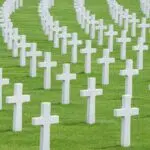St. Martin’s Day, observed on November 11, is the feast day of Saint Martin of Tours, a baptized Roman soldier who became the bishop of a French town. He’s known for cutting his cloak in half to share it with a beggar during a snowstorm. On the same night, he dreamed of Jesus, dressed in a half-cloak, saying to angels, “Here is Martin, the Roman soldier who is now baptized; he has clothed me.” Saint Martin died on November 8, 397, and was interred three days later. His feast day is also known as the Feast of Saint Martin, Martinmas, Old Halloween, or Old Hallowmas Eve,
History of St. Martin’s Day
St. Martin’s Day began in France and proliferated to the Low Countries — the British Isles, Galicia, Germany, Scandinavia, and Eastern Europe. Also known as Martinmas, it is the day when Martin is honored in Mass and marks the beginning of natural winter in the agricultural calendar and the end of autumn in the economic calendar. At this time, plenty of brewed beer and wine becomes available, signaling the end of winter preparations, including animal butchering. Just as during Michaelmas on September 29, devotees eat goose to mark the occasion. The feast is similar to the American Thanksgiving as it celebrates the earth providing for humans.
Martinmas celebrations in some countries begin on the 11th minute of the 11th hour of the 11th day of the 11th month — or at 11:11 a.m. on November 11. Others start the celebrations on St. Martin’s Eve on November 10. In the sixth century, Church councils began requiring fasting through the 56 days, except Saturdays and Sundays, between Saint Martin’s Day and the Epiphany on January 6. This fasting period was known as ‘Quadragesima Sancti Martini,’ or Saint Martin’s Lent, and was similar to the 40 days of fasting during Lent. It was rarely observed before it evolved into the current Advent practice.
Saint Martin’s Day now often involves feasts, dances, and bonfires. After dark, children carry lanterns through the streets, singing songs that earn them candy rewards.
St. Martin’s Day timeline
Spanish forces seize control of Saint Martin from the Dutch, driving most or all of the colonists off the island.
France and the Netherlands sign the Treaty of Concordia, dividing the island between them.
When the Netherlands becomes a puppet state of the French Empire, the French take control of the entire island.
Hurricane Irma causes severe damage, and many residents are left without necessities.
St. Martin’s Day FAQs
Why is St. Martin’s day celebrated?
The feast honors Saint Martin’s life and the end of the agricultural year and harvest.
Why are there lanterns on St. Martin’s Day?
It is typical for children to make lanterns and participate in the procession of paper lanterns in honor of St. Martin. Some speculate that the lanterns are an alternative to the bonfires that characterize Saint Martin’s Day celebrations.
What happens on St. Martin’s Day?
In the parades, young children walk down the streets with candle-lit lanterns and sing Martin songs praising the saint’s generosity.
How to Observe St. Martin’s Day
Participate in the celebrations
Saint Martin’s Day is celebrated in unique ways across the world. Invite your family to join the colorful procession and carry lanterns made from painted paper.
Eat goose
After the lantern procession, devotees usually eat goose for Saint Martin’s Day dinner. Try the tasty dish to honor the tradition!
Enjoy grapes and local wine
As the patron saint of France, Saint Martin is said to help the spread of wine-making across the country. Taste the local grapes and wine with the locals.
5 Fascinating Facts About Saint Martin
The smallest island
St. Martin is the world’s smallest inhabited island shared by two countries, France and the Netherlands.
A constitutional country
Sint Maarten, the island’s Dutch side, is one of the four constituent countries comprising the Kingdom of the Netherlands.
A map of Saint Martin
The island of Saint Martin is roughly halved, with the larger French side covering about 20 square miles.
A large population
The Dutch side of the island has a larger population, an estimated 41,177, while the French side has around 32,489 residents.
An island of salt
The island was called ‘Soualiga,’ or “Land of Salt,” because of the salt ponds scattered throughout the island, prompting the French and British to establish salt mining operations.
Why St. Martin’s Day is Important
It celebrates the island
Saint Martin’s Day commemorates the island’s history and identity. It is known as the world’s smallest island shared by two distinct nations, France and the Netherlands.
It unites two cultures
The island’s two sides have unique qualities. The Dutch south is very urban and modern, whereas the French north has many rugged landscapes and sights for which the tiny island is famous. Despite their differences, both sides celebrate Saint Martin’s Day.
It’s festive
Saint Martin’s Day is celebrated differently across different nations. But most of the celebrations include lantern parades and hearty meals.
St. Martin’s Day dates
| Year | Date | Day |
|---|---|---|
| 2025 | November 11 | Tuesday |
| 2026 | November 11 | Wednesday |
| 2027 | November 11 | Thursday |
| 2028 | November 11 | Saturday |
| 2029 | November 11 | Sunday |




















